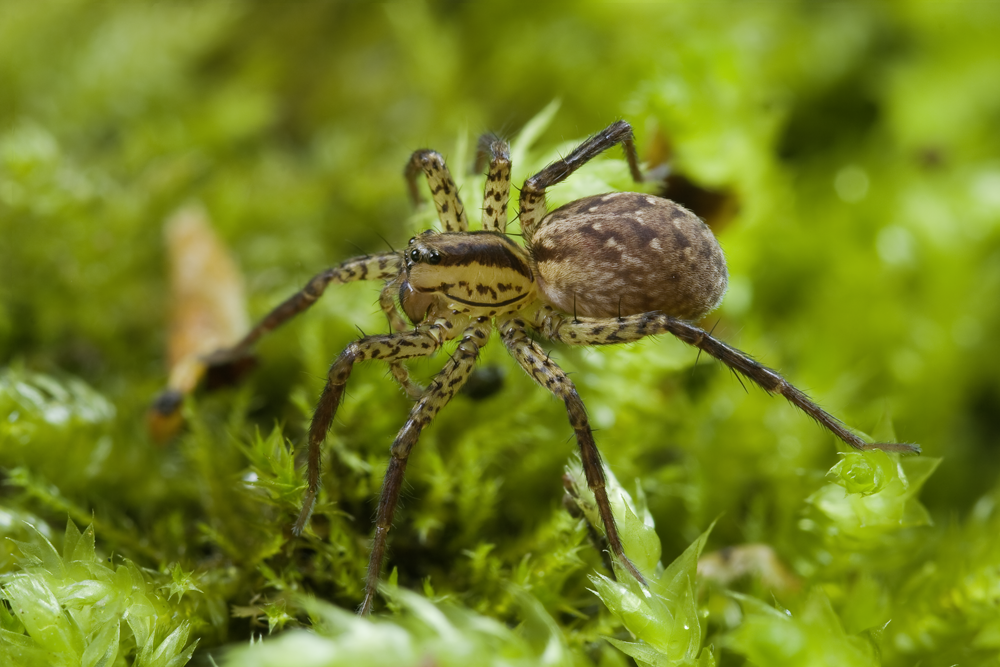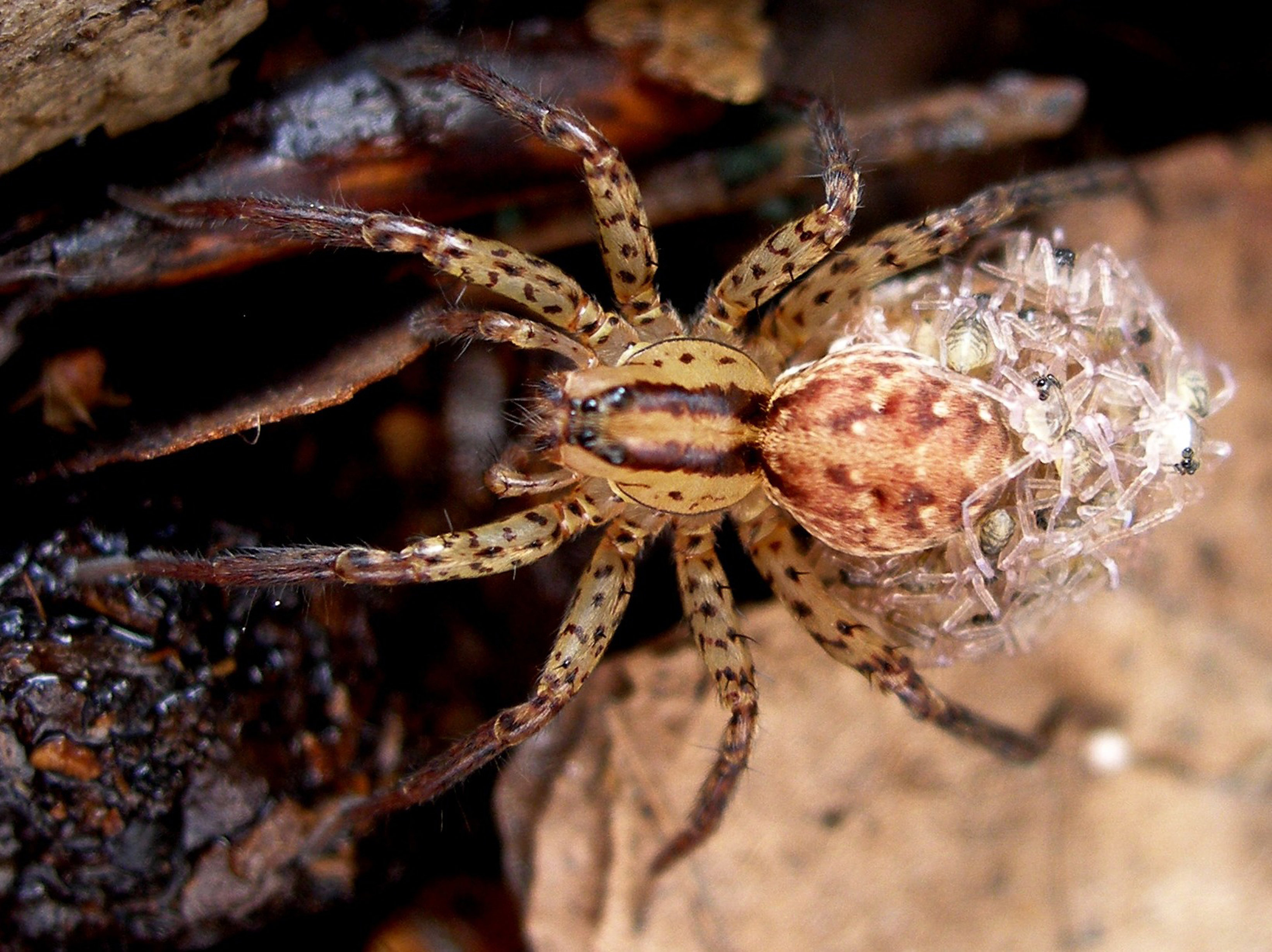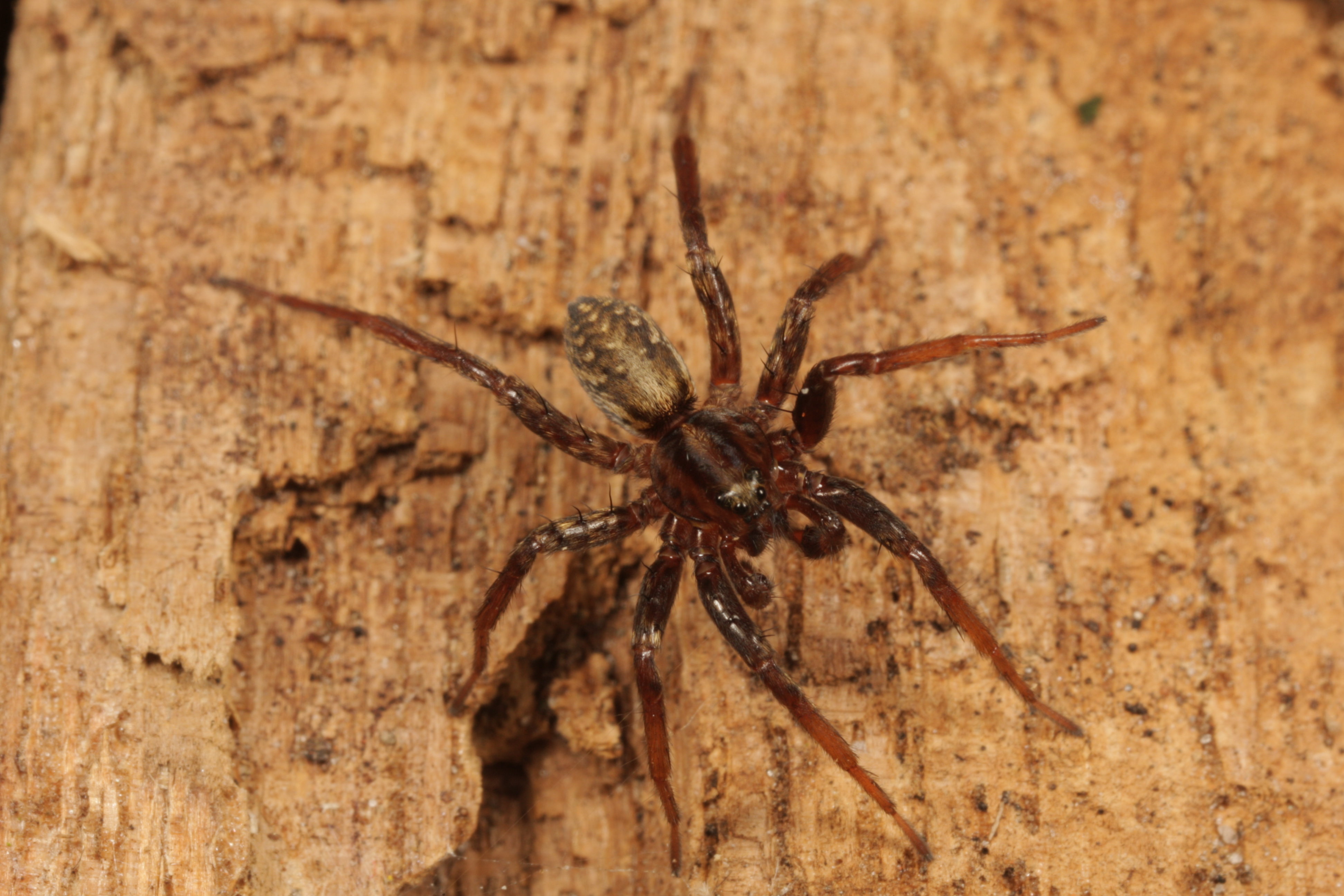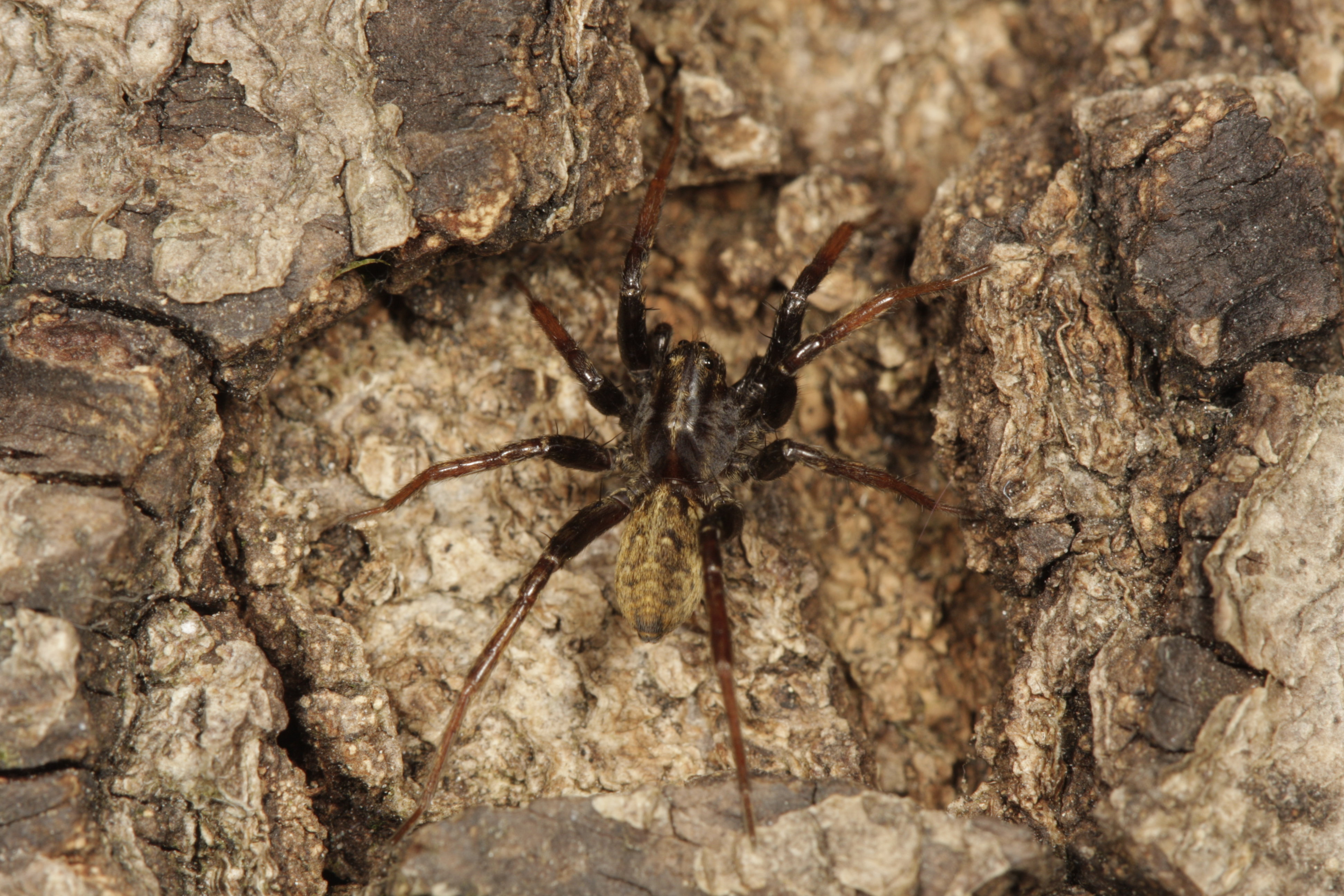Spider of the Year 2022
The drumming wolf spider Hygrolycosa rubrofasciata (Ohlert, 1865)
The drumming wolf spider, Hygrolycosa rubrofasciata (Ohlert, 1865), belongs to the wolf spider family (Lycosidae). This family of spiders has 2440 species throughout the world, of which 352 species are known in Europe. In the genus Hygrolycosa there are only five species world-wide and two species in Europe, of which Hygrolycosa strandi is found only in Greece. Thus the drumming wolf spider is the only representative of this group from Central Europe.
The drumming wolf spider is distributed across the Palaearctic. In Central Europe it is typically found in plains and foothills (up to 800 m above sea level). In Austria, for example, it is one of the rarest spiders with a few records from Vorarlberg, Styria and Burgenland, all associated with its specialized habitat. Hygrolycosa rubrofasciata prefers damp habitats and is thus only found in selected near-natural places such as moors, swamps, wet meadows or wet (canyon) forests. Because of the increasing threats and destruction of several of its preferred habitats, the drumming wolf spider has often been placed on the Red List of endangered animal and plant species. For example, it is rated as threatened by extinction in Austria and as endangered in Germany.
Text: Christoph Hörweg
Description
The body length of Hygrolycosa rubrofasciata is 5 – 6 mm. A difference between the sexes is not – as is often the case in spiders – related to body length (normally females are larger), but instead relates to differences in colouration and markings. Males are almost black. The cephalothrorax has three weakly-defined pale stripes along its length. The abdomen is dark brown to black, with four connected rows of white spots along its length. The legs have two colours, being black and becoming light brown. Females have a light brown cephalothorax, with three pale lines along its length, plus two thin rows of flecks. The abdomen is also pale and the legs are pale brown with dark spots.
Ecology
Like most wolf spiders, the drumming wolf spider does not build a web, but is active during the day as an ambush predator waiting for its prey: principally insects.
During the mating season in spring males drum with their abdomen on dry leaves, making a noise which is audible even to humans as a ‘purring’ drumming sound. This suggests its common name of the drumming wolf spider.
After mating, females lay around 60 eggs in a cocoon. Female wolf spiders are widely known for their careful brood care. They attach the cocoon to their spinnerets and carry it around with them. After the young have hatched, they typically climb onto their mother’s back and are carried around with her. In Hygroylosa rubrofasciata there is a slight difference in this behaviour. Here, the spiderlings do not hold onto their mothers back, but instead grasp the empty cocoon – possibly an adaptation to their damp habitats.
Adult drumming wolf spiders can be found from March to November. Males usually die after mating, but females can often survive the winter.
Similar species
In (Central) Europe the drumming wolf spider is the only species within its genus and is reasonably easy to identify based on its colouration and markings. For inexperienced observers, Hygrolycosa rubrofasciata could be mistaken for the prowling spider Zora spinimana (family Miturgidae), which is found in similar habitats.
Text: Christoph Hörweg
This highly endangered species, which in countries like Austria is close to extinction, should draw attention to the effect of threats and destruction of these animals’ relevant habitats – in this case the drying out of moorlands. This is especially relevant in terms of climate change in that moors have been shown to be increasingly important for carbon storage.
Additionally it is exciting and curious to actually hear a spider drumming. And the behaviour of the spiderlings is also something unusual among wolf spiders, namely the fact that after hatching they remain attached to the cocoon.
By choosing the Spider of the Year a ‘less popular’ animal group should be placed in the spotlight and attention should be drawn to its threatened habitats, but at the same time it is also hoped that scientists will contribute up-to-date information about its distribution. In this context, enjoy the Spider of the Year and help us with locality information or a photograph to document this species.
Text: Christoph Hörweg
Countries involved
Albania, Austria, Belgium, Bulgaria, Croatia, Czech Republic, Denmark, Finland, France, Germany, Great Britain, Hungary, Ireland, Italy, Liechtenstein, Macedonia, The Netherlands, Norway, Poland, Portugal, Serbia, Slovakia, Slovenia, Spain, Sweden, Switzerland.
Supporting societies
- ARABEL - Belgische Arachnologische Vereniging
- ARAGES - Arachnologische Gesellschaft
- BAS - The British Arachnological Society
- CAS - Česká arachnologická společnost
- ESA - European Society of Arachnology
- GIA - Grupo Ibérico de Aracnología
- NATURADATA - Biodiversidade online (Portugal)
- NATURALIS - European Invertebrate Survey-Nederland
Contact for Europe
Dr. Milan Řezáč
Biodiversity Lab, Crop Research Institute
Drnovská 507
161 06 Praha 6 – Ruzyně
Czech Republic
reza(a)cvurv.cz
Distribution
- Europe (link to former maps of spiderling)
- Europe from araneae Spiders of Europe
- in Austria
- in Benelux
- in Czech Republic
- in Germany
- in Great Britain
- in Italy
- in Switzerland
Wikis and photo galeries
- Wiki of the Spinnen-Forum
- Wikimedia commons
- Pierre Ogers Galerie Arachno (Les araignées de Belgique e de France )
- spiderling.de
- Arachnologische Gesellschaft e.V. 2021 Atlas der Spinnentiere Europas (Arachnida: Araneae, Opiliones, Pseudoscorpiones, Amblypygi, Solifugae, Scorpiones, Schizomida) für Hygrolycosa rubrofasciata – (link) (09.12.2021)
- Arachnologische Gesellschaft e.V. 2021 Wiki des Spinnen-Forums – (link) (09.12.2021)
- Bellmann H 2016 Der Kosmos Spinnenführer. Frackh-Kosmos Stuttgart. 429 pp.
- Blick T, Bosmans R, Buchar J, Gajdoš P, Hänggi A, Helsdingen P van, Růžička V, Staręga W & Thaler K 2004 Checkliste der Spinnen Mitteleuropas. Checklist of the spiders of Central Europe. (Arachnida: Araneae). Version 1. Dezember 2004
- Braun R 1976 Zur Autökologie und Phänologie einiger für das Rhein-Main-Gebiet und die Rheinpfalz neuer Spinnenarten (Arachnida: Araneida) – Jahrbücher des Nassauischen Vereins für Naturkunde 103:24-68.
- Breitling R, Merches E, Muster C, Duske K, Grabolle A, Hohner M, Komposch C, Lemke M, Schäfer M & Blick T 2020 Liste der Populärnamen der Spinnen Deutschlands (Araneae) – Arachnologische Mitteilungen 59:38-60. doi: 10.30963/aramit5907
- Buchar J & Thaler K 1995 Die Wolfspinnen von Österreich 2: Gattungen Arctosa, Tricca, Trochosa (Arachnida, Araneida: Lycosidae) Faunistisch-tiergeographische Übersicht – Carinthia II 185./105.:481-498.
- CSCF (Centre Suisse de Cartographie de la Faune) 2019 Fauna der Schweiz – Spinnentiere oder Arachniden (Skorpione, Pseudoskorpione, Spinnen, Weberknechte, Milben) – (link) bzw. Verbreitungskarte für Hygrolycosa rubrofasciata: (link) (07.12.2020)
- Deutsche Digitale Bibliothek 2021 Kultur und Wissen online, Tonaufnahmen, Tierstimmenarchiv vom Museum für Naturkunde Berlin: Hygrolycosa rubrofasciata. (link) (21.12.2021)
- Dolejš P 2013 Do really all wolf spiders carry spiderlings on their opisthosomas? The case of Hygrolycosa rubrofasciata (Araneae: Lycosidae) – Arachnologische Mitteilungen 45:30-35. doi: 10.5431/aramit4507
- Foelix RF 2015 Biologie der Spinnen. Edition Chimaira, Frankfurt am Main. 430 pp.
- Hänggi A, Stöckli E & Nentwig W 1995 Lebensräume mitteleuropäischer Spinnen. Charakterisierung der Lebensräume der häufigsten Spinnenarten Mitteleuropas und der mit diesen vergesellschafteten Arten – Miscellanea Faunistica Helvetiae 4: 1-459
- Helsdingen PJ van 2021 Araneae. In: Fauna Europaea version 2017.06 – (link) (09.12.2021)
- Köhler D & Tembrock G 1987 Akustische Signale bei der Wolfsspinne Hygrolycosa rubrofasciata (Arachnida: Lycosidae) – Zoologischer Anzeiger 219:147–153.
- Kronestedt T 1984 Sound production in the wolf spider Hygrolycosa rubrofasciata (Ohlert) (Araneae, Lycosidae) – Fauna och flora 79(3):97-107.
- Kronestedt T 1996 Vibratory communication in the wolf spider Hygrolycosa rubrofasciata (Araneae, Lycosidae) – Revue Suisse de Zoologie Suppl. 1996:341-354.
- Muster C 2021 Artenportrait Trommelwolf in Rote-Liste-Zentrum. (link) (21.12.2021)
- Nentwig W, Blick T, Bosmans R, Gloor D, Hänggi A & Kropf C 2021 araneae – Spiders of Europe, version 12.2021 – (link) (09.12.2021). doi: 10.24436/1
- Reichholf JH & Steinbach G 1997 Die grosse Enzyklopädie der Insekten, Spinnen und Krebstiere, Band 1. Bertelsmann Lexikon Verlag Gütersloh. 360 pp.
- World Spider Catalog 2021 World Spider Catalog, version 22.5. Natural History Museum Bern – (link) (09.12.2021)








